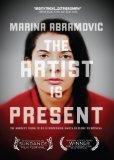| Reviews & Columns |
|
Reviews DVD TV on DVD Blu-ray 4K UHD International DVDs In Theaters Reviews by Studio Video Games Features Collector Series DVDs Easter Egg Database Interviews DVD Talk Radio Feature Articles Columns Anime Talk DVD Savant Horror DVDs The M.O.D. Squad Art House HD Talk Silent DVD
|
DVD Talk Forum |
|
|
| Resources |
|
DVD Price Search Customer Service #'s RCE Info Links |
|
Columns
|
|
|
Marina Abramovic The Artist is Present
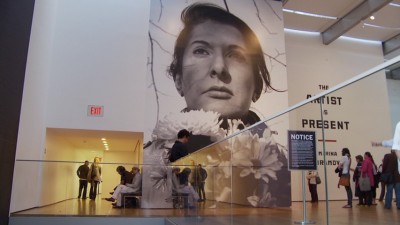
To the world at large, the words "performance art" are probably just as likely to bring to mind images of The Dude's comically timid, enthusiastic but inept dance-piece-performing neighbor in The Big Lebowski, or perhaps Steve Buscemi's overrated stand-up comic in Scorsese's Life Lessons -- stereotypes of the pretentious, otherwise failed artist dressing up their inadequacies as "performance" -- as they are to conjure an actual performance artist like Yugoslavian-born Marina Abramovic, whose work over the last 40 years has a depth and seriousness to it that rival any painting, sculpture, or video art of the same period. This remarkable woman, now 63, has for decades been conceiving of and performing striking, provocative performance pieces of a rigor and accomplishment that, with every resonant conceptual situation and evocative movement within them, puts paid to the notion that performance artists are merely attention-grabbers who make sloppy, self-aggrandizing "art" to be fobbed off on a bewildered or gullible public. In 2010, the Museum of Modern Art in New York held a retrospective of Abramovic's work, which involved gathering an ensemble of younger performers to "re-perform" some of her more iconic pieces from over the years, as well as the creation and performance of a new work, "The Artist is Present." It is this large-scale summing-up event around which documentarian Matthew Akers centers Marina Abramovic: The Artist is Present, a film portrait of the artist that takes us through her biography, her personal life, her work and its history, and some of the more salient and emotionally charged moments from the performance of the title as it unfolded over three months in the summer of 2010.
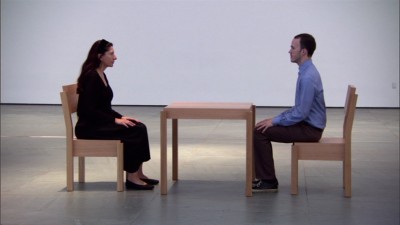
Akers starts us off right in the thick of things, falling in with Abramovic -- a statuesque figure with a Slavic accent and a physical grace, poise, and confidence perfectly suited to her work -- along with her busy assistants and troupe of artists-in-training as they prepare to mount the MoMA retrospective, a fairly massive undertaking in which Abramovic will have instructed and rehearsed her chosen successors to re-enact some of the "classic" performance pieces that brought her to her current, venerated grandmother-of-performance-art status. Through Akers's camera, we're witness to the sometimes bizarre rituals Abramovic puts her bemused trainees through after bringing them to her spacious home/studio outside of the city, as they prepare to recreate such visceral, physically imposing works (excerpted here in filmed or videotaped clips) as 1973's Rhythm 5, wherein the artist lies in the center of a blazing pentagram (Abramovic passed out from the lack of oxygen) and 1975's Lips of Thomas, in which a nude Abramovic carved a Star of David around her navel; abstract performances including Relation in Space (a man and a woman, both naked, appear to unconsciously "orbit" one another, sometimes passing, sometimes colliding) and Relation in Time, in which a man and a woman sit facing away from one another, their long hair braided together behind them to join the two into one being; and audience-participation conceptions like Imponderabilia, in which two nude performers stand, impassive and statue-still, in either side of a too-narrow doorway between exhibit spaces, forcing patrons to squeeze between them. The Artist is Present, the piece newly created for the 2010 retrospective, sounds simple but, as we see, is emotionally exhausting, both for the artist and for any audience participants: Abramovic sits on one side of a table with an empty chair facing her, and any member of the public who reaches the end of the line may sit across from her, at which point she will look into their face and hold the gaze for as long as they wish. For the three months of the retrospective, Abramovic was present for this "performance" at all times during the museum's hours of operation. Even at one remove, witnessing only the moments Akers has chosen from the performance's hundreds of hours, it retains some of its astonishing power; more than a few participants are overwhelmed by the intimacy and end up with tears rolling helplessly down their faces, and we can infer that Abramovic's difficult concept was successfully executed, packing equal parts simplicity and unfathomable force into its emotional-endurance testing high-wire act.
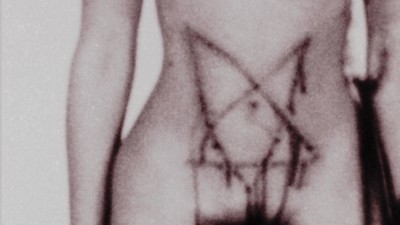
All of the dual-performer works mentioned above were made by Abramovic in conjunction with her former longtime creative and life partner, the single-monikered "Ulay" (the two split in 1988, via a vast-canvas performance piece in which each walked toward the other from opposite ends of China's Great Wall to meet in the middle and part permanently), who reunites awkwardly with Abramovic for Akers's camear and submits to being one of the filmmakers talking heads (others who chime in for interviewsconstitute an array of art-world figures who know and/or work with Abramovic, including art critic Arthur Danto, MoMA curator Klaus Biesenbach, Whitney Museum curator Chrissie Iles, and gallerist Sean Kelly, among others). The reuniting-with-Ulay "storyline" is actually relevant in one sense; when Ulay takes a surprise turn as a participant in the The Artist is Present performance, sitting across from the woman whom he loved and with whom he worked, lived, and traveled for over a decade, it actually does create an emotional moment wherein her work and her biographical past intersect in a fascinating and revealing way. But in another sense, this somewhat contrived narrative padding is trivializing and distracting, juicy but not very meaningful, and overall, the film is probably too heavy on such biographical supplementation; Akers too often succumbs to gimmicky editing (fashion photo shoots! sped-up crowds flocking to see the exhibit!), heavy-handed use of music, and a tone of reality-TV excitability about spying on someone famous at home (other famous friends/museum patrons include David Blaine, James Franco, and, for a split second, Orlando Bloom).
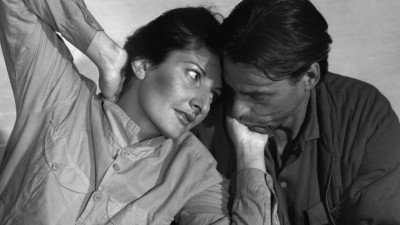
That the filmmakers evidently felt the need to jazz things up, somewhat diluting the power of Abramovic's work, is indicative of what would seem to be an unavoidable, inherent Achilles heel when it comes to making a documentary film about a performance artist -- an obstacle that nothing probably would have helped (and Akers's conventional-skewing editing/music choices definitely doesn't surmount it): The filmmaker can much more easily let us get to know the artist as a biographical individual -- one who chats to the camera throughout and who feels triumphantly vindicated by the MoMA show, which she hopes will take performance art out of the "alternative" ghetto and validate it as a legitimate medium once and for all -- than to really show us her work and help us experience and understand it, because you simply can't "get" performance art on film, at least not in the isolated moments from film and video recordings of Abramovic's work that Akers intercuts into all the commentary and footage of her hectic, soul-searching, but glamorous life. The performance art method of using the artist's physical being and presence as their "materials," their palette, is even less effectively filmable than would be pointing a camera at a theater stage for a single take of a play's performance (the most notoriously bland and uncinematic way of filming a play): the moment-by-moment "liveness," the invisible but living, breathing interaction between audience and artist, cannot be recorded or reproduced, and it's a much more vital, even central, component of performance art than it is even in the theatre.
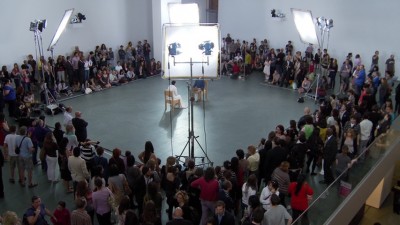
Marina Abramovic: The Artist is Present is thus a cinematically fluent but distinctly un-radical film about an unequivocally radical artist. In its artificially sped-up context, it feels contradictory when one commentator astutely contemplates the playing with time that Abramovic does in "The Artist is Present," musing ruefully that as the world goes faster and faster, it's actually the most subversive act of all to do nothing but sit and silently engage with another person, and then another, and then another, for three months straight; quite unlike the documentary on it that we're watching, Abramovic's performance is a rebuke to and a balm for our unfulfilling harriedness and amputated attention spans. Still, despite the film being (perhaps necessarily) full of truncations and possessed of a superimposed, incongruous, vaguely rushed and unsatisfying feeling when combining too-brief glances and snippets from Abramovic's work with the commentary/testimony of its maker and its champions, it still manages to come off as something credible, however flawed -- a labor of love whose passion for the artist and her work is evident. Even if what that work really is and how it works is told much more than shown, it still offers as good an introduction as descriptions/explanations are likely to offer. In the end, the film intrigues and leaves you wanting to know more, and so it can be said to work insofar as it attains its goal of boosting the artist, introducing us to her via a somewhat over-slick but still entertaining and reasonably enlightening behind-the-scenes biography of its subject and the way she lives and works. It's a sort of appetite-whetting teaser or advertisement for, more than a substantial exposure to, the work itself, but the thumbnail introduction it does manage to give us to an artist who deserves the wide exposure is valuable, and Marina Abramovic: The Artist is Present, for all its limitations, is well worth a look.
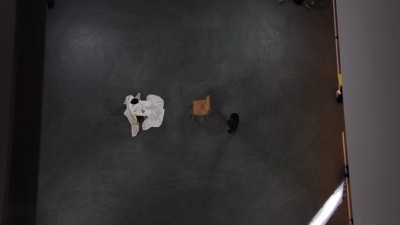
THE DVD:
The 1.78:1 anamorphic-widescreen transfer of Marina Abramovic: The Artist is Present is quite good; the suitability of the high-definition video technology on which it was shot for making the transition to digital home-video media is apparent, with all colors, skin tones, and darks looking good, solid, and natural, and with only a bit of edge enhancement here or there in the way of very noticeable compression artifacts.
Sound:The film's sound is available on the disc in either Dolby 2.0 Stereo or Dolby 5.1 Surround options, either of which convey very well a remarkably well-mixed sound design (especially considering that it's sound caught in large part on the fly) and Nathan Halpern's score in rich, full, clear (and, in 5.1, room-filling) tones with no distortion in the sound or imbalance in the mix discernible at any point.
Extras:--"Marina at the MoMA," (10 min.) an unabridged/longer version of the interview with MoMa director/former Abramovic partner Klaus Eisenbach, heavily excerpted throughout the film, in which he discusses Abramovic as an artist, her work's meaning and reception, the risk of her performances fading away into "urban myth," and, in specific, their collaboration on and co-conceiving of The Artist is Present.
--"The Audience Creates the Work," a six-minute outtake with some further commentary from Abramovic's colleagues who also chime in in the film, but more importantly documenting a large range of audience reactions (from fascinated to perplexed to dismissive), reactions of those who sat across from Abramovic during the The Artist is Present piece, and face time with what can only be described as her fan base, who run the gamut from thoughtful, sincere, passionate admirers to groupies to goofy hangers-on drawn to the fame/celebrity aspect more than the work.
--"Marina: Art vs. Life," a seven-minute outtake/interview with James Westcott, Abramovic's British biographer, in which a more objective, contemplative (though still admiring, thoughtful, and respectful) take on the work, the artist, and phenomenon of Marina Abramovic is offered than remains in the main feature.
--"Marina's Dresses," a brief (two-minute) interview with designer Stina Gunnarsson, who created Abramovic's minimalist, solid-colored gowns (which, as we can see from the flurry of images that depict the artist and dressmaker going over colors, fabrics, and fittings, represent a "minimalism" that required a "maximalist" amount of thought and effort to attain).
--"Belgrade Homecoming," a 10-minute outtake with Abramovic giving us a guided tour of the locales and landmarks of her hometown that remain salient for her, complete with further recollections about her development as an artist and her memories and impressions of creating her work, particularly during her time as a young, developing artist in the former Yugoslovian (now Serbian) capital.
--"A Re-Performer's Story," a six-minute piece on Brittany Bailey, one of the troupe of performers re-staging Abramovic's classic performances for the MoMA retrospective. It's touching and truly supplements the experience of the feature, giving us a look at the biographical backstory of a young (Bailey is 19) dancer who left her upper-middle-class, supportive home in North Carolina to join the retrospective in New York -- a person with a whole life of her own, whom we only know in the film as an ultra-poised hanging nude replicating Abramovic's sly take on da Vinci's famous "Vitruvian Man" drawing, Luminosity.
--The film's theatrical trailer.
--About a dozen still photos from Abramovic's performance pieces over the decades.
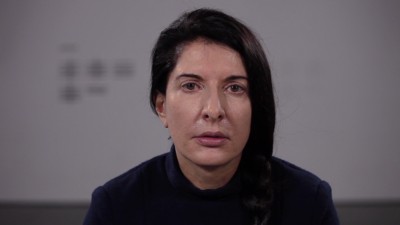
A souvenir for the many of us who never got to experience her work in person (the way they were meant to be seen), Marina Abramovic: The Artist is Present does the most it can to bring the viewer close to the provocative, conceptually bold, and emotionally charged performance art conceived and performed over the decades by the artist of the title (principally focusing on a new piece in which she sits across from museum patrons who have stood in line to be in the artist's presence, simply looking at them for as long as they wish in the sort of eye-to-eye contact generally avoided among strangers). The film also does neophytes a favor by rounding out the development and performance of the new piece (part of a wide-ranging 2010 Museum of Modern Art retrospective) with much biography, history, and commentary on Abramovic and what she does, as well as some fairly privileged glances into the physically rigorous, mentally draining process a dedicated performance artist must undertake to hone their work and engage the public. On those counts, the film is quite interesting, informative, and valuable (it also has the added benefit of having someone with star power for a subject; one doesn't get tired of looking at or listening to the striking, charismatic Abramovic, who at 63 looks not a day older than 40 and has the open-minded, youthful spirit to match). After a certain point, though, it serves mainly as a reminder that performance pieces the likes of which Abramovic creates and enacts resemble theater when it comes to documenting them on film: the camera in and of itself dilutes the most basic, important aspect of the experience, which is "live" before it is anything, so what we end up with is something like a faded, incomplete memory of the performances we see -- fleeting impressions that bear only traces of their full, original power. Still, it's better to experience something so bold, provocative, serious, and often profoundly moving secondhand than not at all, and director Matthew Akers has done the public a real, entertaining, enlightening service by putting Abramovic on the radar of many more of us -- the millions of interested parties outside the art capital of New York and without direct access to The Museum of Modern Art, where her grand retrospective took place -- than will likely ever experience, much less engage with, her in person. Recommended.
|
| Popular Reviews |
| Sponsored Links |
|
|
| Sponsored Links |
|
|
| Release List | Reviews | Shop | Newsletter | Forum | DVD Giveaways | Blu-Ray | Advertise |
|
Copyright 2024 DVDTalk.com All Rights Reserved. Legal Info, Privacy Policy, Terms of Use,
Manage Preferences,
Your Privacy Choices | |||||||









